when和while;过去进行时
- 格式:doc
- 大小:84.50 KB
- 文档页数:5
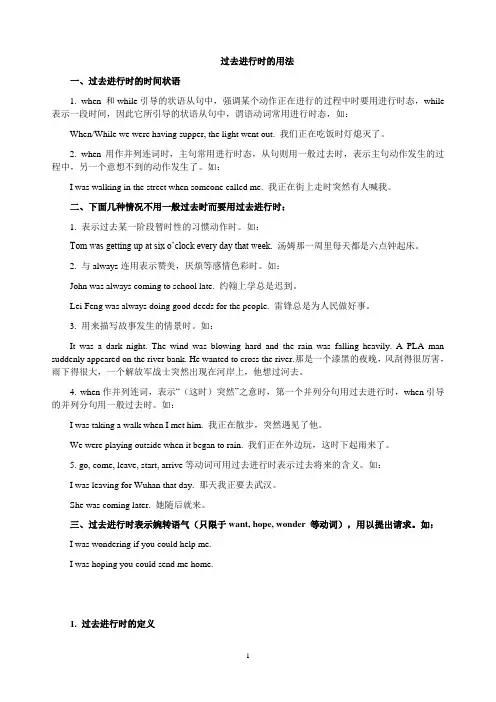
过去进行时的用法一、过去进行时的时间状语1. when 和while引导的状语从句中,强调某个动作正在进行的过程中时要用进行时态,while 表示一段时间,因此它所引导的状语从句中,谓语动词常用进行时态,如:When/While we were having supper, the light went out. 我们正在吃饭时灯熄灭了。
2. when用作并列连词时,主句常用进行时态,从句则用一般过去时,表示主句动作发生的过程中,另一个意想不到的动作发生了。
如:I was walking in the street when someone called me. 我正在街上走时突然有人喊我。
二、下面几种情况不用一般过去时而要用过去进行时:1. 表示过去某一阶段暂时性的习惯动作时。
如:Tom was getting up at six o’clock every day that week. 汤姆那一周里每天都是六点钟起床。
2. 与always连用表示赞美,厌烦等感情色彩时。
如:John was always coming to school late. 约翰上学总是迟到。
Lei Feng was always doing good deeds for the people. 雷锋总是为人民做好事。
3. 用来描写故事发生的情景时。
如:It was a dark night. The wind was blowing hard and the rain was falling heavily. A PLA man suddenly appeared on the river bank. He wanted to cross the river.那是一个漆黑的夜晚,风刮得很厉害,雨下得很大,一个解放军战士突然出现在河岸上,他想过河去。
4. when作并列连词,表示“(这时)突然”之意时,第一个并列分句用过去进行时,when引导的并列分句用一般过去时。
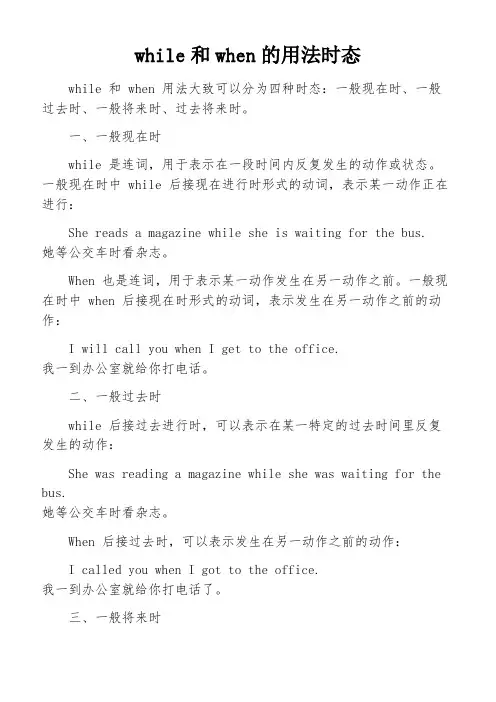
while和when的用法时态while 和 when 用法大致可以分为四种时态:一般现在时、一般过去时、一般将来时、过去将来时。
一、一般现在时while 是连词,用于表示在一段时间内反复发生的动作或状态。
一般现在时中 while 后接现在进行时形式的动词,表示某一动作正在进行:She reads a magazine while she is waiting for the bus.她等公交车时看杂志。
When 也是连词,用于表示某一动作发生在另一动作之前。
一般现在时中 when 后接现在时形式的动词,表示发生在另一动作之前的动作:I will call you when I get to the office.我一到办公室就给你打电话。
二、一般过去时while 后接过去进行时,可以表示在某一特定的过去时间里反复发生的动作:She was reading a magazine while she was waiting for the bus.她等公交车时看杂志。
When 后接过去时,可以表示发生在另一动作之前的动作:I called you when I got to the office.我一到办公室就给你打电话了。
三、一般将来时while 后接将来进行时,可以表示在某一特定的将来时间里反复发生的动作:She will be reading a magazine while she is waiting for the bus.她等公交车时会看杂志。
When 后接将来时,表示发生在另一动作之前的动作:I will call you when I get to the office.我一到办公室就给你打电话。
四、过去将来时while 后接过去将来时,可以表示在某一特定过去将来时间里反复发生的动作:She would be reading a magazine while she was waiting for the bus.她等公交车时会看杂志。
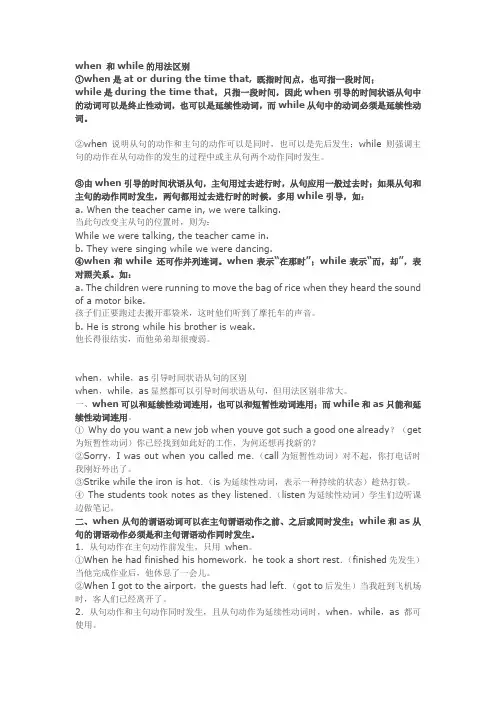
when 和while的用法区别①when是at or during the time that, 既指时间点,也可指一段时间;while是during the time that,只指一段时间,因此when引导的时间状语从句中的动词可以是终止性动词,也可以是延续性动词,而while从句中的动词必须是延续性动词。
②when 说明从句的动作和主句的动作可以是同时,也可以是先后发生;while 则强调主句的动作在从句动作的发生的过程中或主从句两个动作同时发生。
③由when引导的时间状语从句,主句用过去进行时,从句应用一般过去时;如果从句和主句的动作同时发生,两句都用过去进行时的时候,多用while引导,如:a. When the teacher came in, we were talking.当此句改变主从句的位置时,则为:While we were talking, the teacher came in.b. They were singing while we were dancing.④when和while 还可作并列连词。
when表示“在那时”;while表示“而,却”,表对照关系。
如:a. The children were running to move the bag of rice when they heard the sound of a motor bike.孩子们正要跑过去搬开那袋米,这时他们听到了摩托车的声音。
b. He is strong while his brother is weak.他长得很结实,而他弟弟却很瘦弱。
when,while,as引导时间状语从句的区别when,while,as显然都可以引导时间状语从句,但用法区别非常大。
一、when可以和延续性动词连用,也可以和短暂性动词连用;而while和as只能和延续性动词连用。
①Why do you want a new job when youve got such a good one already?(get 为短暂性动词)你已经找到如此好的工作,为何还想再找新的?②Sorry,I was out when you called me.(call为短暂性动词)对不起,你打电话时我刚好外出了。
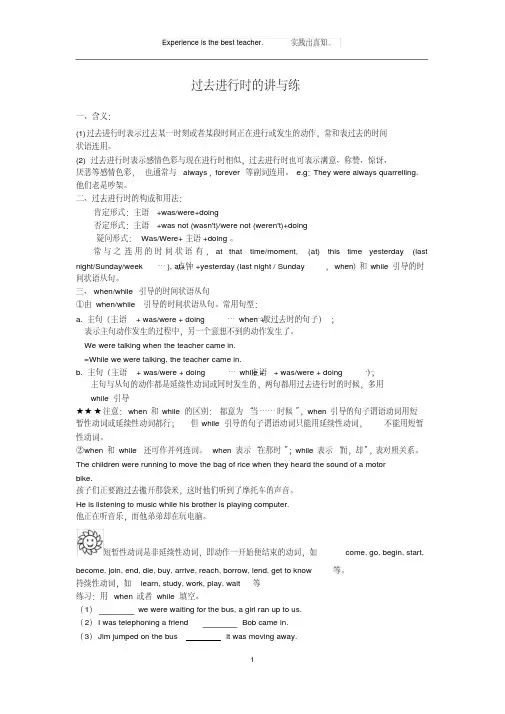
过去进行时的讲与练一、含义:(1)过去进行时表示过去某一时刻或者某段时间正在进行或发生的动作,常和表过去的时间状语连用。
(2) 过去进行时表示感情色彩与现在进行时相似,过去进行时也可表示满意、称赞、惊讶、厌恶等感情色彩,也通常与always,forever等副词连用。
e.g:They were always quarrelling. 他们老是吵架。
二、过去进行时的构成和用法:肯定形式:主语+was/were+doing否定形式:主语+was not (wasn't)/were not (weren't)+doing疑问形式:Was/Were+主语+doing。
常与之连用的时间状语有,at that time/moment, (at) this time yesterday (last,when 和while引导的时night/Sunday/week…), at+点钟+yesterday (last night / Sunday…)间状语从句。
三、when/while引导的时间状语从句①由when/while 引导的时间状语从句。
常用句型:一般过去时的句子);a. 主句(主语+ was/were + doing … when +表示主句动作发生的过程中,另一个意想不到的动作发生了。
We were talking when the teacher came in.=While we were talking, the teacher came in.);主语+ was/were + doing … b. 主句(主语+ was/were + doing … while +主句与从句的动作都是延续性动词或同时发生的,两句都用过去进行时的时候,多用while引导★★★注意:when和while的区别:都意为“当……时候”,when引导的句子谓语动词用短暂性动词或延续性动词都行;但while引导的句子谓语动词只能用延续性动词,不能用短暂性动词。
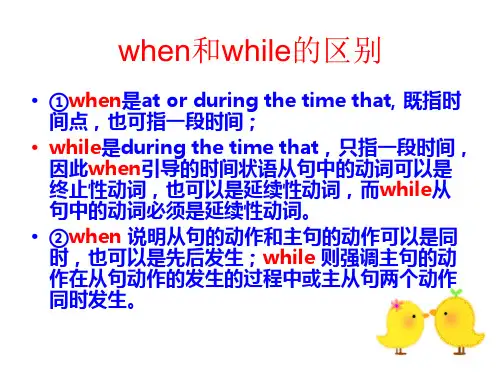
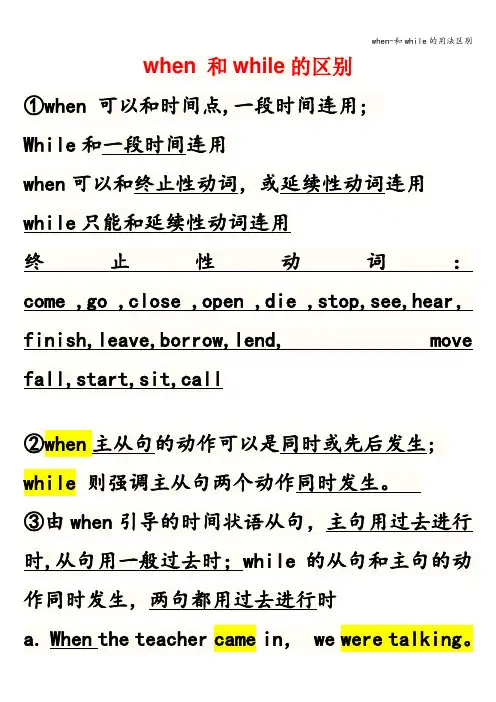
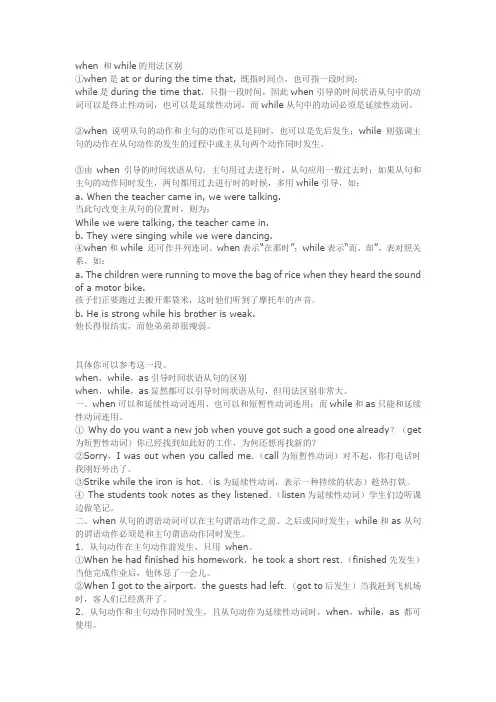
when 和while的用法区别①when是at or during the time that, 既指时间点,也可指一段时间;while是during the time that,只指一段时间,因此when引导的时间状语从句中的动词可以是终止性动词,也可以是延续性动词,而while从句中的动词必须是延续性动词。
②when 说明从句的动作和主句的动作可以是同时,也可以是先后发生;while 则强调主句的动作在从句动作的发生的过程中或主从句两个动作同时发生。
③由when引导的时间状语从句,主句用过去进行时,从句应用一般过去时;如果从句和主句的动作同时发生,两句都用过去进行时的时候,多用while引导,如:a. When the teacher came in, we were talking.当此句改变主从句的位置时,则为:While we were talking, the teacher came in.b. They were singing while we were dancing.④when和while 还可作并列连词。
when表示“在那时”;while表示“而,却”,表对照关系。
如:a. The children were running to move the bag of rice when they heard the sound of a motor bike.孩子们正要跑过去搬开那袋米,这时他们听到了摩托车的声音。
b. He is strong while his brother is weak.他长得很结实,而他弟弟却很瘦弱。
具体你可以参考这一段。
when,while,as引导时间状语从句的区别when,while,as显然都可以引导时间状语从句,但用法区别非常大。
一、when可以和延续性动词连用,也可以和短暂性动词连用;而while和as只能和延续性动词连用。
①Why do you want a new job when youve got such a good one already?(get 为短暂性动词)你已经找到如此好的工作,为何还想再找新的?②Sorry,I was out when you called me.(call为短暂性动词)对不起,你打电话时我刚好外出了。
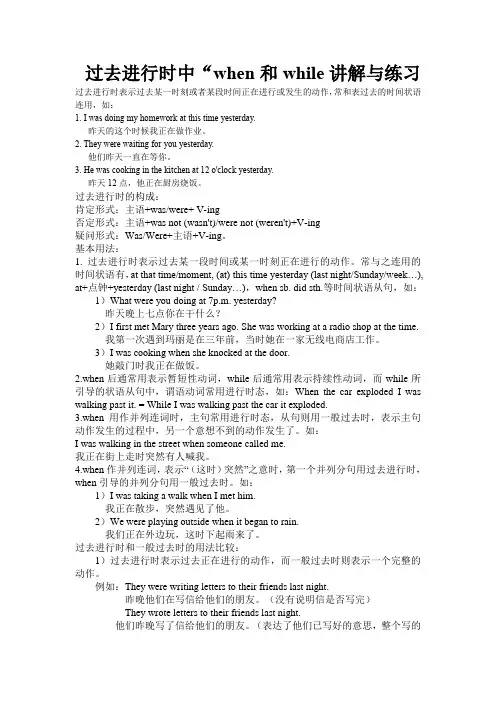
过去进行时中“when和while讲解与练习过去进行时表示过去某一时刻或者某段时间正在进行或发生的动作,常和表过去的时间状语连用,如:1. I was doing my homework at this time yesterday.昨天的这个时候我正在做作业。
2. They were waiting for you yesterday.他们昨天一直在等你。
3. He was cooking in the kitchen at 12 o'clock yesterday.昨天12点,他正在厨房烧饭。
过去进行时的构成:肯定形式:主语+was/were+ V-ing否定形式:主语+was not (wasn't)/were not (weren't)+V-ing疑问形式:Was/Were+主语+V-ing。
基本用法:1. 过去进行时表示过去某一段时间或某一时刻正在进行的动作。
常与之连用的时间状语有,at that time/moment, (at) this time yesterday (last night/Sunday/week…), at+点钟+yesterda y (last night / Sunday…),when sb. did sth.等时间状语从句,如:1)What were you doing at 7p.m. yesterday?昨天晚上七点你在干什么?2)I first met Mary three years ago. She was working at a radio shop at the time.我第一次遇到玛丽是在三年前,当时她在一家无线电商店工作。
3)I was cooking when she knocked at the door.她敲门时我正在做饭。
2.when后通常用表示暂短性动词,while后通常用表示持续性动词,而while所引导的状语从句中,谓语动词常用进行时态,如:When the car exploded I was walking past it. = While I was walking past the car it exploded.3.when用作并列连词时,主句常用进行时态,从句则用一般过去时,表示主句动作发生的过程中,另一个意想不到的动作发生了。
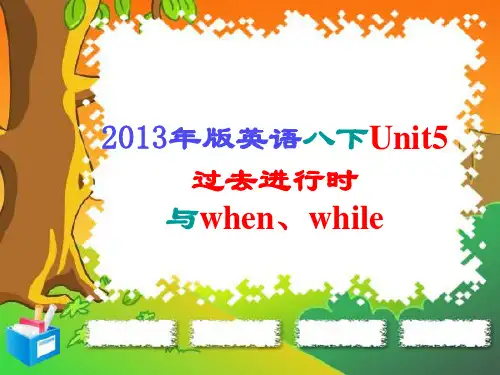
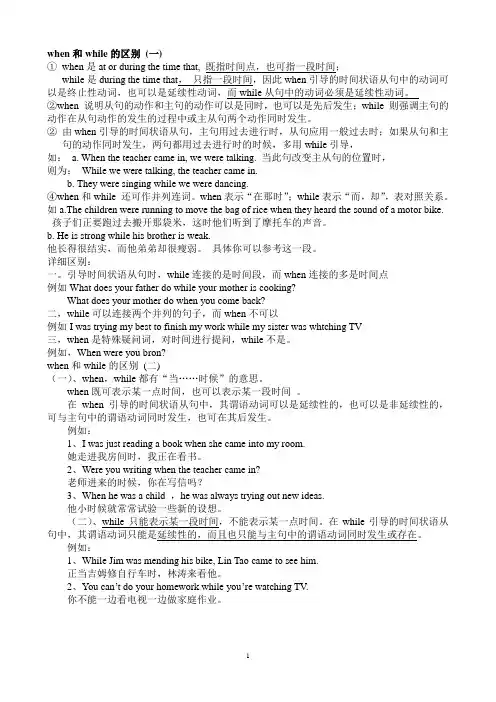
when和while的区别(一)①when是at or during the time that, 既指时间点,也可指一段时间;while是during the time that,只指一段时间,因此when引导的时间状语从句中的动词可以是终止性动词,也可以是延续性动词,而while从句中的动词必须是延续性动词。
②when 说明从句的动作和主句的动作可以是同时,也可以是先后发生;while 则强调主句的动作在从句动作的发生的过程中或主从句两个动作同时发生。
②由when引导的时间状语从句,主句用过去进行时,从句应用一般过去时;如果从句和主句的动作同时发生,两句都用过去进行时的时候,多用while引导,如: a. When the teacher came in, we were talking. 当此句改变主从句的位置时,则为:While we were talking, the teacher came in.b. They were singing while we were dancing.④when和while 还可作并列连词。
when表示“在那时”;while表示“而,却”,表对照关系。
如a.The children were running to move the bag of rice when they heard the sound of a motor bike. 孩子们正要跑过去搬开那袋米,这时他们听到了摩托车的声音。
b. He is strong while his brother is weak.他长得很结实,而他弟弟却很瘦弱。
具体你可以参考这一段。
详细区别:一。
引导时间状语从句时,while连接的是时间段,而when连接的多是时间点例如What does your father do while your mother is cooking?What does your mother do when you come back?二,while可以连接两个并列的句子,而when不可以例如I was trying my best to finish my work while my sister was whtching TV三,when是特殊疑问词,对时间进行提问,while不是。
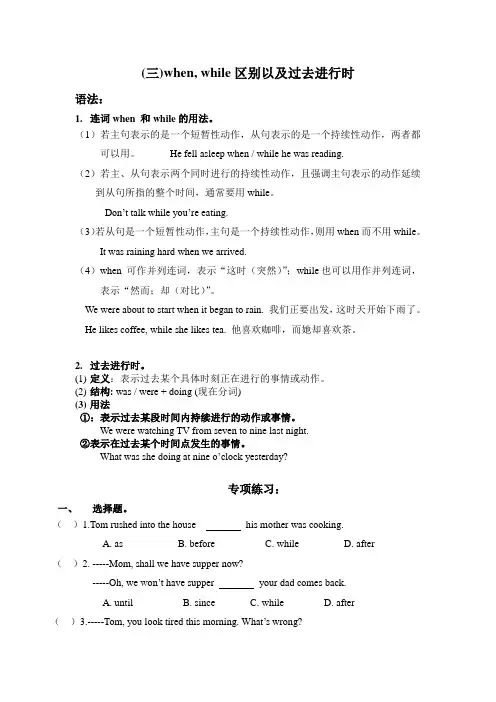
(三)when, while区别以及过去进行时语法:1.连词when 和while的用法。
(1)若主句表示的是一个短暂性动作,从句表示的是一个持续性动作,两者都可以用。
He fell asleep when / while he was reading.(2)若主、从句表示两个同时进行的持续性动作,且强调主句表示的动作延续到从句所指的整个时间,通常要用while。
Don’t talk while you’re eating.(3)若从句是一个短暂性动作,主句是一个持续性动作,则用when而不用while。
It was raining hard when we arrived.(4)when 可作并列连词,表示“这时(突然)”;while也可以用作并列连词,表示“然而;却(对比)”。
We were about to start when it began to rain. 我们正要出发,这时天开始下雨了。
He likes coffee, while she likes tea. 他喜欢咖啡,而她却喜欢茶。
2.过去进行时。
(1)定义:表示过去某个具体时刻正在进行的事情或动作。
(2)结构: was / were + doing (现在分词)(3)用法①:表示过去某段时间内持续进行的动作或事情。
We were watching TV from seven to nine last night.②表示在过去某个时间点发生的事情。
What was she doing at nine o’clock yesterday?专项练习:一、选择题。
()1.Tom rushed into the house his mother was cooking.A. asB. beforeC. whileD. after()2. -----Mom, shall we have supper now?-----Oh, we won’t have supper your dad comes back.A. untilB. sinceC. whileD. after()3.-----Tom, you look tired this morning. What’s wrong?-----I was so busy that I didn’t go to bed 12 o’clock last night.A. untilB. whenC. thoughD. unless()4. Jack likes reading a newspaper he is having breakfast.A. andB. whileC. because()5. -----Ring me up you come to my house, will you?-----Sure, I will.A. thoughB. whileC. beforeD. until()6. Eddie was sleeping Millie was reading a magazine.A. untilB. whileC. beforeD. after()7. the 632-meter Shanghai Tower is finished, it will be the second tallest building in the world.A. WhenB. SinceC. BeforeD. Unless()8.Mary a dress when she cut her finger.A. madeB. is makingC. was makingD. makes ()9. When Jim’s mother came in, he his homework.A. is doingB. has doneC. was doing()10. -----What did you do yesterday evening, Gina?-----I Titanic 3D in the City Cinema.A. watchB. watchedC. am watchingD. will watch ()11. Paul and I tennis yesterday. He did much better than I.A. playB. will playC. playedD. are playing()12. -----I call you at 6 o’clock yesterday evening, but nobody answered.-----I’m sorry. I my friend downloaded the movie Kung Fu Panda 2 when the telephone rang.A. would helpB. helpedC. was helping()13. Yesterday evening, I along the street when I suddenly met my math teacher.A. walkB. walkedC. was walkingD. am walking()14. The girl with two cats in the yard when the earthquake happened.A. was playingB. is playingC. are playingD. were playing()15. -----What did Mr. Smith do before he came to China?-----He in a car factory.A. workedB. worksC. is workingD. will work综合练习:一、完形填空。
过去进行时的讲与练一、含义:(1) 过去进行时表示过去某一时刻或者某段时间正在进行或发生的动作,常和表过去的时间状语连用。
(2) 过去进行时表示感情色彩与现在进行时相似,过去进行时也可表示满意、称赞、惊讶、厌恶等感情色彩,也通常与always , forever 等副词连用。
e.g : They were always quarrelli ng. 他们老是吵架。
二、过去进行时的构成和用法:肯定形式:主语 +was/were+do ing否定形式:主语 +was no t (was n't)/were no t (were n't)+do ing疑问形式:Was/Were+主语 +doing。
常与之连用的时间状语有,at that time/mome nt, (at) this time yesterday (lastni ght/S un day/week …),at+ 点钟 +yesterday (last ni ght / Sun day …), whe n 禾口while引导的时间状语从句。
三、 when/while引导的时间状语从句①由when/while 引导的时间状语从句。
常用句型:a. 主句(主语 + was/were + doing …when + 一般过去时的句子);表示主句动作发生的过程中,另一个意想不到的动作发生了。
We were talk ing whe n the teacher came in.=While we were talk ing, the teacher came in.b. 主句(主语 + was/were + doing …while + 主语 + was/were + doing …);主句与从句的动作都是延续性动词或同时发生的,两句都用过去进行时的时候,多用 while 引导★★★注意:when和while的区别:都意为当......... 时候” when引导的句子谓语动词用短暂性动词或延续性动词都行;但while引导的句子谓语动词只能用延续性动词,不能用短暂性动词。
while与when的用法when和while的区别:①when是at or during the time that, 既指时间点,也可指一段时间; while是during the time that,只指一段时间,因此when引导的时间状语从句中的动词可以是终止性动词,也可以是延续性动词,而while 从句中的动词必须是延续性动词。
②when 说明从句的动作和主句的动作可以是同时,也可以是先后发生;while 则强调主句的动作在从句动作的发生的过程中或主从句两个动作同时发生。
③由when引导的时间状语从句,主句用过去进行时,从句应用一般过去时;如果从句和主句的动作同时发生,两句都用过去进行时的时候,多用while引导④when和while 还可作并列连词。
when表示“在那时”;while表示“而,却”,表对照关系。
when,while,as引导时间状语从句的区别when,while,as显然都可以引导时间状语从句,但用法区别非常大。
一、when可以和延续性动词连用,也可以和短暂性动词连用;而while 和as只能和延续性动词连用。
二、when从句的谓语动词可以在主句谓语动作之前、之后或同时发生;while和as从句的谓语动作必须是和主句谓语动作同时发生。
1.从句动作在主句动作前发生,只用when。
2.从句动作和主句动作同时发生,且从句动作为延续性动词时,when,while,as都可使用。
3.当主句、从句动作同时进行,从句动作的时间概念淡化,而主要表示主句动作发生的背景或条件时,只能用as。
这时,as常表示“随着……”;“一边……,一边……”之意。
4.在将来时从句中,常用when,且从句须用一般时代替将来时。
三、when用于表示“一……就……”的句型中(指过去的事情)。
sb.had hardly(=scarcely) done sth.when...=Hardly / Scarcely had sb.done sth.when...。
when 和while的用法区别①when是at or during the time that, 既指时间点,也可指一段时间;while是during the time that,只指一段时间,因此when引导的时间状语从句中的动词可以是终止性动词,也可以是延续性动词,而while从句中的动词必须是延续性动词。
②when 说明从句的动作和主句的动作可以是同时,也可以是先后发生;while 则强调主句的动作在从句动作的发生的过程中或主从句两个动作同时发生。
③由when引导的时间状语从句,主句用过去进行时,从句应用一般过去时;如果从句和主句的动作同时发生,两句都用过去进行时的时候,多用while引导,如:a. When the teacher came in, we were talking.当此句改变主从句的位置时,则为:While we were talking, the teacher came in.b. They were singing while we were dancing.④when和while 还可作并列连词。
when表示“在那时”;while表示“而,却”,表对照关系。
如:a. The children were running to move the bag of rice when they heard the sound of a motor bike.孩子们正要跑过去搬开那袋米,这时他们听到了摩托车的声音。
b. He is strong while his brother is weak.他长得很结实,而他弟弟却很瘦弱。
when,while,as引导时间状语从句的区别when,while,as显然都可以引导时间状语从句,但用法区别非常大。
一、when可以和延续性动词连用,也可以和短暂性动词连用;而while和as只能和延续性动词连用。
①Why do you want a new job when youve got such a good one already?(get 为短暂性动词)你已经找到如此好的工作,为何还想再找新的?②Sorry,I was out when you called me.(call为短暂性动词)对不起,你打电话时我刚好外出了。